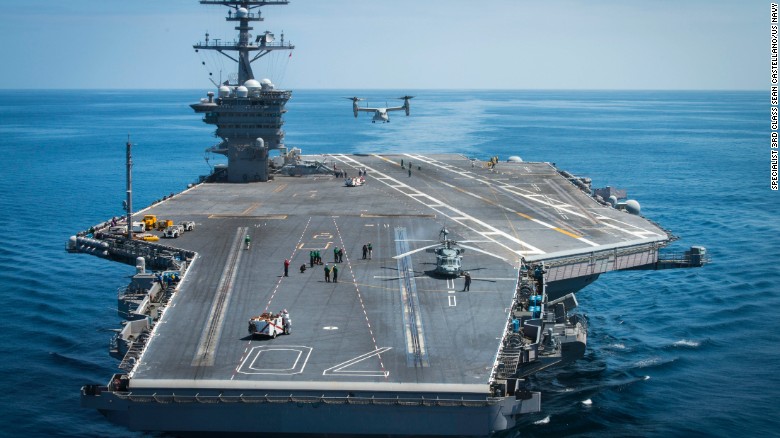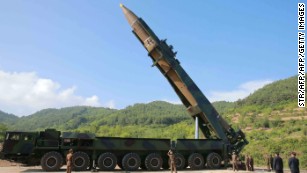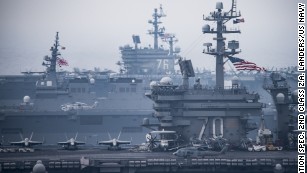North Korea accuses Trump of declaring war
Washington (CNN)North Korea's Foreign Minister Ri Yong Ho on Monday accused US President Donald Trump of declaring war on his country by tweeting over the weekend that North Korea "won't be around much longer."
"Last weekend Trump claimed that our leadership wouldn't be around much longer and declared a war on our country," Ri said, according to an official translation of his remarks to reporters in New York.
Where are the world's nuclear weapons?
"Since the United States declared war on our country, we will have every right to make all self-defensive counter measures, including the right to shoot down the United States strategic bombers at any time even when they are not yet inside the aerospace border of our country," Ri said.
White House press secretary Sarah Sanders said Monday that the US has not declared war on North Korea, adding, "Frankly, the suggestion of that is absurd."
Sanders said it is "never appropriate" to shoot down another nation's aircraft in international waters and the administration plans to continue to protect the area.
Earlier on Monday, State Department spokesperson Katina Adams told CNN the US seeks a "peaceful denuclearization of the Korean Peninsula."
But the US military "will take all options to make sure that we safeguard our allies and our partners and our homeland so if North Korea does not stop their provocative actions we'll make sure we provide options to the President to deal with North Korea," according to Col. Rob Manning, a Pentagon spokesman.
As US military flexes, North Korea marches toward nuclear capability
Asked about Ri's charge that Trump's comments were a declaration of war, Manning, said: "Our job as the Department of Defense is as you know is to make sure that the President is provided military options, we'll continue to do that, and we have a deep arsenal of military options to provide the President so then he can decide how he wants to deal with North Korea and the regime."
"We are postured and we are ready to fight tonight," he added.
The US Navy will also continue to maintain its presence near the Korean peninsula despite the latest round of harsh rhetoric and threats of a military strike from Pyongyang.
PHOTOS: US aircraft carriers
Lightning strikes over the flight deck of the USS John C. Stennis, another Nimitz-class aircraft carrier, as the ship moves through the Persian Gulf in 2007. All of the Navy's 10 active aircraft carriers are from the Nimitz class, which started in 1975 with the commission of the USS Nimitz.
Hide Caption
16 of 31
PHOTOS: US aircraft carriers
The USS Ranger (CV-61) arrives at Pearl Harbor, Hawaii, in 1993. The Forrestal-class carrier, which featured in the movie "Top Gun," is to be scrapped this year.
Hide Caption
17 of 31
PHOTOS: US aircraft carriers
In this photo released by the U.S. Navy, a tugboat works alongside the decommissioned aircraft carrier USS Saratoga on Thursday, August 21, in Newport, Rhode Island. The Navy has paid a Texas recycling company a penny to dispose of the Saratoga, part of the Forrestal-class of "supercarrier" vessels built for the Atomic Age. The carrier was decommissioned 20 years ago.
Hide Caption
18 of 31
PHOTOS: US aircraft carriers
Aircrew members are lifted from the flight deck of the USS John F. Kennedy during an exercise in 2002. The ship, which was decommissioned in 2007, was the only member of its class.
Hide Caption
19 of 31
PHOTOS: US aircraft carriers
An F/A-18 Hornet launches from the USS Enterprise in 2007. The Enterprise, the world's first nuclear-powered aircraft carrier, was decommissioned in 2012. Like the John F. Kennedy, it was the only ship built in its class.
Hide Caption
20 of 31
PHOTOS: US aircraft carriers
The Kitty Hawk class was named for the USS Kitty Hawk, seen here departing Yokosuka, Japan, in 2008. At that time, the Kitty Hawk was the oldest carrier in the U.S. Navy and the only conventional-power aircraft carrier still in commission. It was decommissioned in 2009.
Hide Caption
21 of 31
PHOTOS: US aircraft carriers
The USS Independence, a member of the Forrestal class that preceded the Kitty Hawk class, heads up the East River in New York in 1959.
Hide Caption
22 of 31
PHOTOS: US aircraft carriers
Helicopters sit on the flight deck of the USS Saipan during the mid-1950s. The ship was one of two members of the Saipan class.
Hide Caption
23 of 31
PHOTOS: US aircraft carriers
The USS Midway, namesake of the Midway class of aircraft carriers, floats off the coast of North Vietnam in 1972. It was named after the Battle of Midway, when U.S. forces held back a Japanese attempt to take the Pacific atoll in 1942.
Hide Caption
24 of 31
PHOTOS: US aircraft carriers
The USS Princeton, part of the Independence class, moves off the coast of Seattle in 1944.
Hide Caption
25 of 31
PHOTOS: US aircraft carriers
The Essex-class USS Franklin burns after being hit by a Japanese dive bomber in 1945. The ship was named after Benjamin Franklin and nicknamed "Big Ben."
Hide Caption
26 of 31
PHOTOS: US aircraft carriers
The USS Wasp burns in the Coral Sea after being struck by three torpedoes from a Japanese submarine in 1942. The ship, the only one of its class, would ultimately sink because of the damage.
Hide Caption
27 of 31
PHOTOS: US aircraft carriers
B-25 bombers sit on the deck of the USS Hornet in the Pacific Ocean in 1942. The Hornet, one of three carriers in the Yorktown class, was the ship that launched the bombers flown by Air Force Lt. Col. James Doolittle and his pilots during an air raid in Tokyo four months after the attack on Pearl Harbor. It also was involved in the Battle of Midway.
Hide Caption
28 of 31
PHOTOS: US aircraft carriers
Navy personnel work on board the USS Ranger circa 1942. The Ranger was the first ship to be designed and built specifically as an aircraft carrier. It was the only ship in its class.
Hide Caption
29 of 31
PHOTOS: US aircraft carriers
There have actually been two aircraft carriers named after the Revolutionary War's Battle of Saratoga. The first USS Saratoga, seen here moving toward San Francisco's Golden Gate Bridge in 1945, was one of two members of the Lexington class of aircraft carriers.
Hide Caption
30 of 31
PHOTOS: US aircraft carriers
The USS Langley, the Navy's first aircraft carrier and sole member of its class, steams off the coast of Baltimore in 1924.
Hide Caption
31 of 31

PHOTOS: US aircraft carriers
A MV-22B Osprey, from Marine Operational Test and Evaluation Squadron 1, lifts off from the flight deck of the aircraft carrier USS Carl Vinson (CVN 70) on June 12, 2016. Click through the gallery to see other US aircraft carriers.













